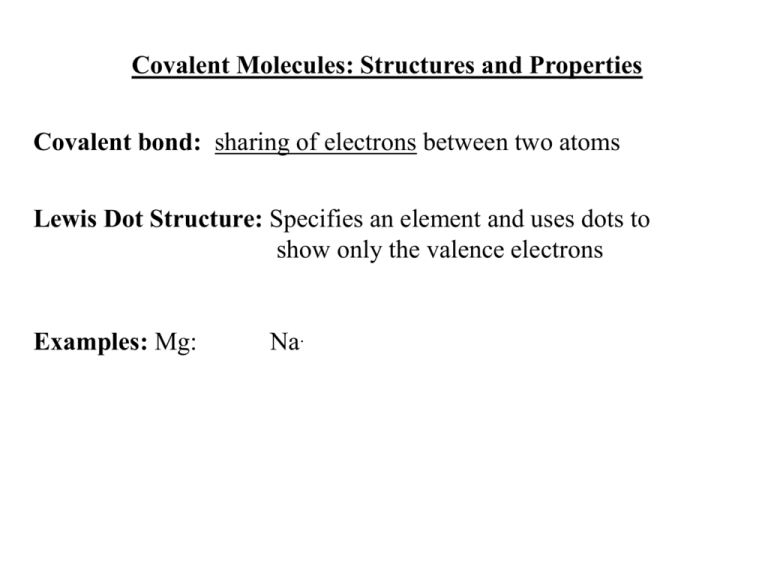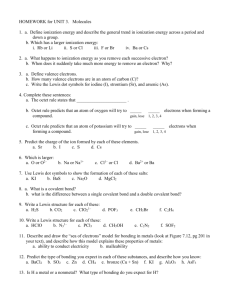Chapter 4 ppt
advertisement

Covalent Molecules: Structures and Properties Covalent bond: sharing of electrons between two atoms Lewis Dot Structure: Specifies an element and uses dots to show only the valence electrons Examples: Mg: Na. Lewis Dot Structures of Covalent Molecules Drawing Lewis Dot Structures 1. Establish a skeletal structure a. least electronegative atom in center b. H, F often at ends, seldom in center c. carbon likes to form C-C chains 2. Determine the total number of valence electrons in the entire compound a. add up valence electrons for each atom b. add an electron for each negative charge c. subtract an electron for each positive charge 3. Place a pair of electrons between bonded atoms 4. Move electron pairs around as needed to satisfy the octet rule for the central atom (double or triple bonds may be necessary) 5. Double check that each atom has a full octet and that the total number of electrons shown matches that calculated in step #2 Covalent Bond: A sharing of electrons between 2 atoms to fulfill the octet rule Examples: H. + H. H2; HF, H2O We can also use a dash (-) to represent a covalent bond between atoms: H-F, H-O-H Double Bond: Bond resulting from the sharing of 2 electrons; stronger than a single bond Example: CO2 O=C=O Triple Bond: Bond resulting from the sharing of 3 electrons; stronger than a double bond Exceptions to the Octet Rule •Most of the common elements generally follow the octet rule. •H is a notable exception, because it needs only 2 e− in bonding. •Elements in group 3A do not have enough valence e− to form an octet in a neutral molecule. F F B F only 6 e− on B •Elements in the third row have empty d orbitals available to accept electrons. •Thus, elements such as P and S may have more than 8 e− around them. O HO P OH OH 10 e− on P O HO S OH O 12 e− on S Naming Covalent Compounds Covalent bonds usually occur between non-metals Name of the less electronegative element first Stem of the name of the more electronegative element plus the “ide” suffix Indicate the number of each type of atom by using the Greek prefix (mono, di, tri, etc.) (omit “mono” from the first element) Examples: N2O5 = Dinitrogen pentoxide CO2 = Carbon Dioxide, CCl4 = Carbon tetrachloride Practice: BF3 = ? SO3 = ? Molecular Geometry: VSEPR Theory Covalent compounds exist as 3-dimensional structures; we can predict these shapes based on electron arrangement VSEPR Theory: Valence-Shell Electron Pair Repulsion theory; electron pairs in the valence shell repel each other and try to get as far away from each other as possible Central Atom: any atom in a molecule or ion that is bonded to 2 or more other atoms Electron pairs around a central atom orient themselves as far away from each other as possible Linear: 2 pairs of electrons around central atom, orient on opposite sides of the central atom (180o apart) Trigonal Planar: 3 pairs of electrons around central atom, orient in a triangle around the central atom (120o apart) Tetrahedral: 4 bonded pairs of electrons orient around the central atom in the middle (109.5o apart) Trigonal pyramidal: 3 bonded pairs and 1 lone pair of electrons orient in a tetrahedron around the central atom (107 o apart) Bent/Angular: 2 bonded pairs of electrons and 2 lone pairs of electrons orient in a tetrahedron around the central atom (104.5o apart) Examples of Covalent Molecular Shapes Linear Trigonal planar Tetrahedral Trigonal Pyramid Bent/Angular When counting the number of electron pairs surrounding a central atom, remember: All valence shell electron pairs count, whether they are bonding pairs or lone pairs Double or triple bonds are counted like a single pair of electrons when predicting shapes Determining Molecular Shape from Lewis Dot Structure Polarity of Covalent Bonds Not all atoms attract electrons to the same degree Electronegativity (En): Tendency of an atom to attract shared electrons of a covalent bond Electronegativity increases across Periodic Table, decreases down Periodic Table Electronegativity and the Periodic Table Electronegativity Values Nonpolar Covalent Bond: Covalent bond in which the bonding electrons are shared equally by both atoms Example: Cl-Cl, H-H Polar Covalent Bond: Covalent bond in which the bonded electrons are shared unequally Example: H-Cl, H-O-H This polarization (unequal distribution of electrons) results in “partial charges” on the atoms within the covalently bonded molecule, while the net charge on the molecule remains zero. The more electronegative atom acquires a partial negative charge (d-); the less electronegative atom acquires a partial positive charge (d+) Example: H-Cl H has less electronegativity than Cl Therefore electrons are more attracted to Cl atom d+ dH-Cl Practice: I-Cl The greater the difference in electronegativity between bonded atoms, the more polar the bond Lewis Dot Structures and Polarity of Molecules Whole molecules can also be described as either polar or nonpolar Polar molecules: molecules with uneven charge distribution; a positive end and a negative end to the molecule (dipole) Nonpolar molecules: molecules whose charge distribution is symmetrical within the molecule; no positive or negative part Examples: H2 is a nonpolar molecule HCl is a polar molecule H2O is a very polar molecule Polarity affects many properties (solubility, melting point, boiling point) Intermolecular forces: interactions between different molecules Intramolecular forces: interactions within a molecule; the bonds between atoms that hold a molecule together Molecules with more intermolecular forces have higher melting and boiling points (ionic, polar covalent, nonpolar covalent) Summary and Key Points Ionic bond vs. Covalent bond Polar vs. nonpolar covalent bond Electronegativity Lewis Dot structures! Writing formulas for ionic compounds Naming ionic and covalent compounds VSEPR theory, molecular shape, polarity







